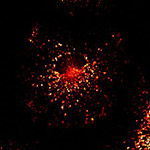Genetics, Bioinformatics and Systems Biology Colloquium
Thursdays, 12:00 pm – 1:00 pm
UC San Diego, Powell-Focht Bioengineering Hall, Fung Auditorium
Complete schedule here
Better cancer treatments can be found by studying the genetic networks they involve, according to a study published by SDCSB researchers. While individual cancer patients vary greatly in the precise mutations that drive tumors, they can be grouped into similar genetic networks that mesh with response to therapy, stated the study, published in Nature Methods.

Trey Ideker
Its senior author is Trey Ideker, division chief of genetics in the UCSD School of Medicine. The first author is Matan Hofree, of UCSD’s department of computer science and engineering. The authors call this approach “network-based stratification,” or NBS. It groups patients together who have mutations in similar networks, matching them with outcomes. The study examined ovarian, uterine and lung cancers in The Cancer Genome Atlas.
“It is widely appreciated that cancer is a disease not of individual mutations, nor of genes, but of combinations of genes acting in molecular networks corresponding to hallmark processes such as cell proliferation and apoptosis,” the study stated.
The study reported what it called a “particularly promising finding” in subtype1 of ovarian cancer. In that type, a pathway called FGF was especially prominent. The pathway is known for tumor growth and angiogenesis, and inhibitors are in clinical trials.
“Specifically, it has been shown that increased expression of FGF1 is associated with poor survival in ovarian cancer, and inhibition of FGFR1 and FGFR2 increases sensitivity to (the commonly prescribed ovarian cancer drug) cisplatin in ovarian cancer cell lines,” the study stated. “An intriguing question for future work is whether subtype 1 patients are particularly responsive to therapy directed at network-identified targets, such as treatment with inhibitors of FGFR1.”
Sequencing the genomes of individual cancers has only recently become practical. The cost of genome sequencing has greatly declined due to technological advances by sequencing companies such as Life Technologies and Illumina. So the genomes of individual tumors can be matched against what’s already known. When that’s done, it becomes evident that cancers tend to follow certain recognizable pathways, regardless of which specific mutations are involved.
“Using this knowledge, we were able to cluster somatic mutation profiles into robust tumor subtypes that are biologically informative and have a strong association to clinical outcomes such as patient survival time and emergence of drug resistance,” the study stated.
A 2012 presentation on the work presented at a symposium of The Cancer Genome Atlas is available online in PDF.
The study is titled, “Network-based stratification of tumor mutations.” It was funded by grants from the National Institutes of Health.













